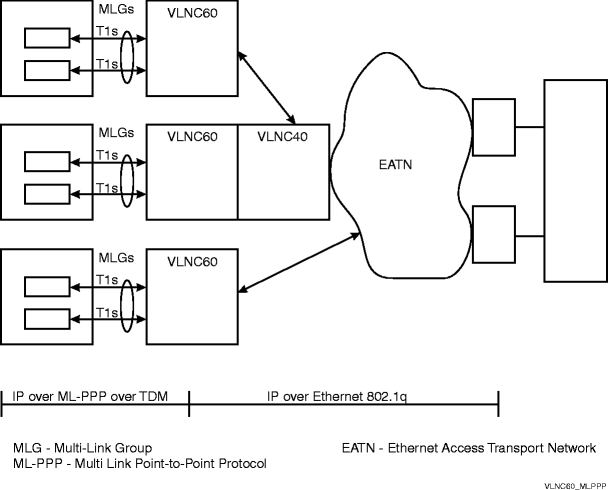Procedure 18-2: Configure Multi-Link PPP (ML-PPP) Termination on VLNC60/VLNC61/VLNC62
 Overview
Overview
Use this procedure to provision Multi Link Point-to-Point Protocol (ML-PPP) termination on the VLNC60/61/62 to provide an interworking between ML-PPP and Ethernet interfaces for IP backhaul applications. The VLNC60/61/62 terminates the ML-PPP session and transmits the IP traffic directly over the packet network using Ethernet 802.1q encapsulation.
It is assumed the circuit packs have been installed and the interface mode has been set. The interface-mode {t1 | e1} command configures the pack’s T1/E1 mode. Refer to the Alcatel-Lucent 1850 Transport Service Switch (TSS-5) Command Line Interface Guide, for help on using CLI commands.
Important!
The example commands in these procedures use an arbitrary prompt (ALU Switching) in illustrating the commands. The actual default prompt, (ALU 1850TSS-5-60, 61, or 62), for the VLNC60/61/62 circuit pack you are logged into may appear or the prompt you chose when setting up the system using the set prompt command.
Step
1 |
Perform the following procedures :
End of steps |
Multi-Link PPP Termination on VLNC60/61/62
See Figure 18-1, Multi-Link PPP termination on VLNC60/61/62 for reference.
On the T1/E1 interface side, the VLNC60/61/62 supports T1/E1 access ports (VLNC60 [8 T1/E1 ports], VLNC61/62 [16 T1/E1 ports]) and a logical interface, called a multilink interface, for each MLPPP multilink group. The multilink interface coordinates the configuration of the bundled link, and presents a single object for the aggregate links. For the VLNC60, the maximum number of T1/E1s per MLG is eight (8), and the maximum number of MLGs is eight (8). For the VLNC61/62, the maximum number of T1/E1s per MLG is 16, and the maximum number of MLGs is 16 per VLNC61/62.
On the Ethernet side, the VLNC60/61/62 supports two SFPs for GbE or 100Mbps ports as uplinks to the EATN network or connected to a VLNC40/42 (on the same Alcatel-Lucent 1850 TSS-5, or a different Alcatel-Lucent 1850 TSS-5).
Up to 8 T1/E1s (VLNC60) or 16 T1/E1s (VLNC61/62) may be grouped into one or more Multi-link Groups (MLGs). The application traffic is just treated as an IP packet payload to the VLNC60/61/62. The VLNC60/61/62 terminates the ML-PPP, reassembling any MLG fragments, and interworks the MLG with Ethernet. The VLNC60/61/62 performs a layer 3 route lookup in a route table containing a configured default route and possibly static routes to determine the layer 3 next hop, and then sends the IP packet encapsulated in an 802.1q header over the appropriate port (using dynamic or static ARP to determine the IP to MAC address mapping of the next hop). The Ethernet frames could (if configured) be tagged with a VLAN that is mapped to a source IP address/port of the MLG.
In the other direction, the traffic will be received by the VLNC60/61/62 as IP over Ethernet, and then interworked to ML-PPP. The Ethernet header is stripped. Based on an IP lookup of direct routes to the destination, the VLNC60/61/62 will bundle (and possibly segment) nearly simultaneous traffic IP frames destined to the same MLG and send them to the destination over the ML-PPP connection.
Figure 18-1: Multi-Link PPP termination on VLNC60/61/62
